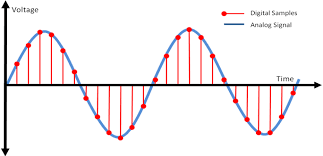

Analogue to digital encoding
image ©aivpcoreyless.blogspot.co.ukWhen we talk the sound waves are analogue sound waves but these need to be converted to a stream of numbers, which can be converted to a stream of bits. A standard A-D converted can do this task as well as the reverse task to convert the bits to sound waves. One criteria is that the receiver can still listen to a high quality recording
The sound wave is sampled at at given rate, 8kHz is the base level used in the telephone system. For many higher quality audio recordings are sampled at 48Khz is used. Whichever is used, the system is to convert from Analogue to Digital is still the same.
At the given sampling rate the amplitude of the wave is measured. For 8bits there are 256 different levels; for 16bits there are 65536 levels. Thus the analogue wave is converted to a series of numbers.
The problem is that this a large number of numbers. because the original wave is an analogue / continuous wave a lot of this information is redundant. Consider a single height level of 125 (for example); then the next value which is taken 1/8000th of a second later will be near to this value. So we record sone absolute values, and then a lot of changes from this value. This cuts the data down significantly. The data reduction technique is RPE-LTP, Regular Pulse Excited - Long Term Prediction. For basic telephone sampling the analogue wave is split into blocks each holding with data stored an absolute vale then offsets.
Whilst this seems complex the conversion process is carried out in hardware not software and is thus very fast.
© mobilephonetechnology.co.uk all rights reserved 2017-2025
